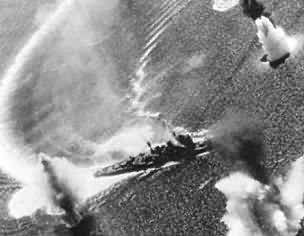
5 November 1944:
The NACHI is off Cavite Naval Base. Vice Admiral Shima is ashore when Task Force 38 hits Manila with four successive waves of strike aircraft. After the second wave, the NACHI gets underway undamaged for the safety of the open sea, but she is attacked by about 60 planes. At 1250, the NACHI is attacked by a third wave of Task Group 38.3's aircraft from USS TICONDEROGA (CV-14) and the LEXINGTON (CV-16) off Corregidor Island.
About five bombs hit her and two, possibly three, torpedoes hit her in the starboard boiler rooms. The NACHI is immobilized. The destroyer AKEBONO is dispatched to assist her.
In the engagement, Nachi was hit at least nine times with torpedoes as well as rockets. She was broken into three parts by two large explosions and sank at 16:45 hours in the middle of a large oil slick at 14°31'N 120°44'E
Of the crew, 807 were lost, including the captain, while 220 survived. Nachi's flag commander, Vice Admiral Kiyohide Shima was ashore for a conference at the time of the attack, but arrived at dockside in time to watch in horror as his flagship was blown apart.
John Prados, in his book, Combined Fleet Decoded, writes that a major intelligence coup was the finding of a large set of code documents on tables and in drawers in the wreckage by US Navy divers. They were surprised that the documents were not even in a safe. It was important because Nachi was the flagship of the Second Striking Force at the time. Early Japanese radar equipment was also recovered.
The original wartime caption of a picture taken of the sinking Nachi by Lexington aircraft reads:
"Note by target coordinator: We circled down to 20 feet to make sure there were absolutely no survivors. Fifteen or twenty oily figures were served with .50-caliber just to make sure."
It has been speculated that a large amount of gold was on board Nachi when she was sunk, which was later recovered by American divers. However, this is a heavily-disputed and questionable claim, which is not asserted by the majority of academics, and is not believed to be the case as there is little evidence for it.
Squadron Highlights
Lt. J.W. Fair, USN was the first VF-80 pilot to destroy an enemy aircraft in the air.
Japanese heavy cruiser NACHI sunk by planes of air group 80 NACHI.
Japanese Kumano class cruiser sunk by planes of air group 80 KUMANO.
More Coming Soon.









